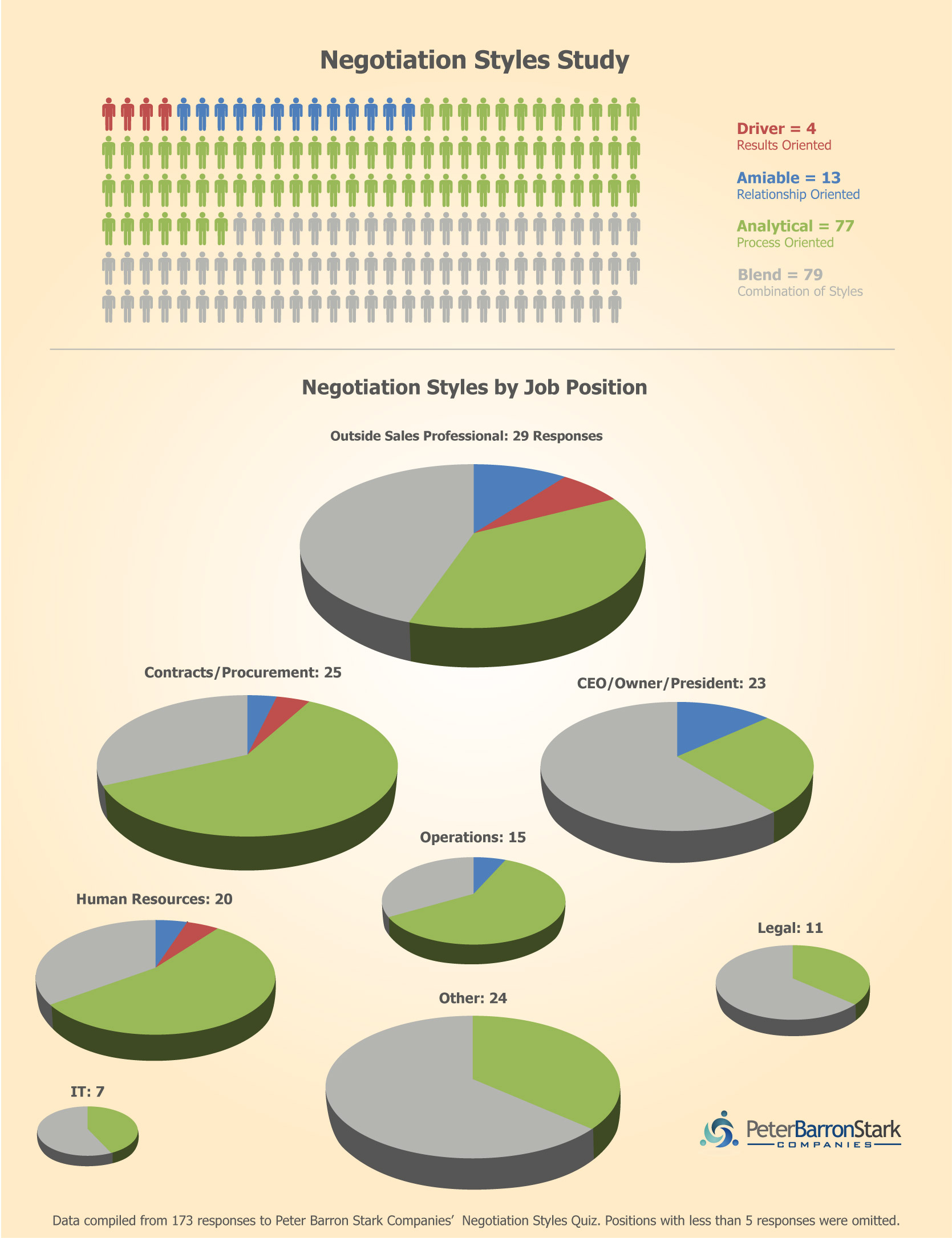Each style’s values are clearly represented in the results of the study
 For the past month, we’ve been advertising our Negotiation Styles quiz with the goal of compiling demographic information on negotiation styles. We asked participants to answer 10 questions about themselves and to specify their job positions.
For the past month, we’ve been advertising our Negotiation Styles quiz with the goal of compiling demographic information on negotiation styles. We asked participants to answer 10 questions about themselves and to specify their job positions.
The results revealed more to us than we expected.
Before we delve into the results, here’s a quick refresher of the four different negotiation styles.
Let’s start with the Amiables, also referred to as the Blues. Amiables’ focus tends to be on preserving the relationships that are involved in the negotiations and ensuring that both parties are happy with the outcome. They are interested in showing genuine care and have a strong desire to feel valued in the negotiation.
While Amiables are focused on the relationship with their counterpart, Drivers, also known as Reds, are bottom-line results oriented individuals. In negotiations, Drivers are concerned mostly with winning and are less concerned about their relationship with their counterpart. They tend to be assertive, time oriented and persuasive.
At the other end of the behavioral spectrum are the Analyticals, Greens, who calmly and methodically explore all options and focus on facts and statistics to obtain a fair and economical outcome.
The fourth style is the Blends. Blends are negotiators who show no clear preference for any of the other three styles. Effortlessly using a combination of styles, blends tend to be personable, flexible, creative and open to change.
Which style best describes your negotiation approach?
Realize that these styles extend past traditional negotiation scenarios and can help provide insight on how we, and others, deal with relationships in general.
Last month when we asked our readers to participate, our desire was to give our readers and the general public an idea of the percentages of each style and which job positions they tend to gravitate towards in an effort to help readers better prepare for future negotiations.
Looking at the results, it is apparent that the representations are skewed. While this may not be a completely accurate portrayal of the typical demographics of the general public’s behavioral styles, it does accurately illustrate each style’s values. Before looking at the results below, can you guess which type had the least amount of responses?
With their bottom line, results-oriented focus, Drivers would be the least interested in taking part in a study like this, particularly if there was no direct relationship to their bottom line and no tangible reward. Only 4 out of 173 respondents were Drivers. It’s likely that in the general population, they are more numerous than what we see here. According to our experience, we estimate Drivers being at roughly 30 percent of the population.
Amiables may be slightly more interested in taking part in this survey than Drivers. However, it might be accurate to assume that if this survey had been conducted in person with volunteers interacting with the Amiables, they would be more represented than the 12 out of 173 respondents that our results display. Based on our experience, Amiables account for roughly 40 percent of the population.
The next style that is more numerous in the results is Analyticals. Notice the jump between Amiables, 12, and Analyticals, 77. This makes sense since Analyticals are drawn to gathering facts and information from the world around them through which to build their knowledge and ability to confidently negotiate. Though they are highly represented here, we would put Analyticals at around 20 percent of the general population.
Possibly the most surprising result is the numerous Blends that responded. Blend responses outnumbered Analyticals, putting them at 79 responses: the most numerous of all. Based on our experience, in the general population, Blends can be estimated to be at around 10 percent of the population. To speculate, the difference between their high participation rate vs their lower estimated percentage among the general population could be because of Blend’s preference for generally being personable, interested in their negotiation relationship, need for options and desire to experiment.
While the representation of styles in the graph’s population shows a response skewed towards Analyticals and Blends, the Styles by job position may be more true to life.
Here is what jumps out to us in terms of the job positions:
It makes sense that more than half of the Outside Sales Professionals would be a combination of Amiables and Blends, mostly Blends, since success in these positions is dependant on the relationship and a personable approach. Contracts and procurement require a high attention to detail and the majority of this sample consists of Analyticals: attention to detail is one of Analyticals’ strongest traits. CEOs and owners/presidents work with many different people and have to handle many different situations throughout the day and, since Blends are known for their versatility, the percentages match up with our expectations. Traditionally, we can and should expect more Reds in the CEOs position, however, the results of this chart make sense: Reds are time oriented and are the least likely to participate in studies of this nature. Reds are even less likely to participate if they are a CEO or the owner of a company.
When we set out to conduct this informal survey, we had hopes of helping readers understand which styles they might expect to encounter in negotiations. Instead our results reiterated an important fact that we share in our relationship strategies courses: there are exceptions to every rule and the behaviors of individuals are just that: individual. As human beings, it is our nature to take assumptions with us when we embark on something new, especially a negotiation. However, we must look past our assumptions and use our powers of observation, listening and questioning.
What are your thoughts on the results? Join the conversation on twitter with the hashtag #PBSStyles
Want to have an advantage over your negotiation partner? Click here to learn how to identify the different negotiation styles.
You may also like:





Speak Your Mind